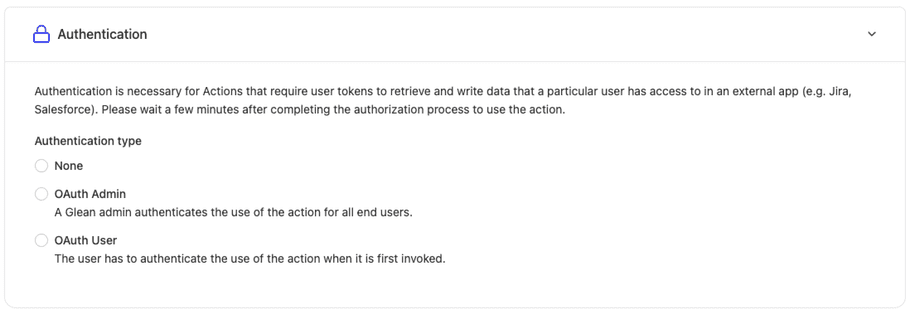Authentication
In this page, we provide information to answer the following questions:
Authentication information provided by Glean
Broadly, currently Glean supports the OAuth 2.0 standard to enable servers to authenticate requests. When developing an action, under the authentication section - you will see 3 options:

1. None Authentication Type
No tokens are provided in the request. Choose this method if you require no tokens from Glean specifically to handle the request. Action developers may choose this method if they already have access in their server to either retrieve relevant data (or) take actions initiated by the user.
Important
If this authentication type is set - it is highly recommend to follow the steps outlined below to verify that requests are coming from Glean. If there are no further protections on the server endpoint (eg. VPN, Firewall) - then this endpoint would be publicly accessible via the internet.
2. OAuth Admin Authentication Type
Here, the action developer (or admin for the app) needs to authorize once at setup time. Once this is successful, glean will send the token for all requests issued by all users for whom the action is deployed to.
3. Oauth User Authentication Type
Here, the action developer (or admin for the app) will provide a few initial details re: the oauth connection itself (see below). Once this is done, the glean user will need to authorize the action when the action is invoked for the first time. All subsequent calls from that user will be authenticated by sending the user's token in the request to the actions server.
Oauth setup parameters
There are a few parameters to be set when configuring OAuth (admin or user) in the actions setup step. All of these follow the OAuth authorization_code grant type:
- Client ID : The client ID for your OAuth application.
- Client Secret : The client secret for your OAuth application.
- Client URL : The URL that will be used to redirect the user to authenticate.
- Authorization URL : Glean will use this to complete the OAuth step by issuing a POST request with the authorization code.
-
Scopes
: An optional parameter to include relevant scopes for your application.
Note:
Depending on the OAuth app, it is recommended to add an
offline_accessscope if the app supports it to ensure refresh tokens are sent ( reference ).
Important
The OAuth App must be configured to allow redirects (aka Callback URL) to the following URL to be able to exchange the code for a token:
https://{your-glean-instance}-be.glean.com/tools/oauth/verify_code/{toolName}
Otherwise the OAuth integration might not work, or you might see an error indicating an invalid redirect URI.
How to verify requests coming from Glean
Note
This is an optional, but highly recommended step that could be performed in the actions server when it receives a request from Glean to improve the security posture of the actions server endpoints.
TL;DR Glean always provides a token signature in the header under Glean-Tools-Signature. This token signature can be verified using the public key available for your glean instance. Follow the code snippets below to perform the verification.
Details
Glean provides a JWT based signature in a header Glean-Tools-Signature which is signed using a private key based on RSA-SHA256 algorithm. The public key is available via the following URL: https://{your-glean-instance}-be.glean.com/api/tools/v1/verification_key. We package the following claims in the JWT header (note that we use standard claims):
- iat : Issued at time
- exp : Expiration time
- iss : Issuer - Which is always set to 'glean'
Code Snippets
Below are code snippets to perform the verification.
import jwt
import json
import requests
# Fill your glean instance here.
YOUR_GLEAN_INSTANCE=''
# Use this function as isin your code (once you have filled out YOUR_GLEAN_INSTANCE).
# Pass the header value for Glean-Tools-Signature as the 'token' in this function.
def verify_jwt(token):
try:
# First, we fetch the public key JSON response.
response = requests.get(f"https://{YOUR_GLEAN_INSTANCE}-be.glean.com/api/tools/v1/verification_key")
response.raise_for_status() # Raises an exception for 4XX/5XX responses
public_key_str = response.json()['publicKey']
# Second, we convert this into the PEM format.
pem_key = f"-----BEGIN PUBLIC KEY-----\n{public_key_str}\n-----END PUBLIC KEY-----"
# Finally, we attempt to decode the token using the public key.
decoded = jwt.decode(token, pem_key, algorithms=['RS256'],issuer='glean')
return True
except jwt.PyJWTError as e:
# Handle error (e.g., token expired, token tampered, etc.)
print(f"JWT verification failed: {e}")
return Falseimport java.util.Base64;
import java.security.KeyFactory;
import java.security.NoSuchAlgorithmException;
import java.security.PublicKey;
import java.security.spec.InvalidKeySpecException;
import java.security.spec.X509EncodedKeySpec;
import org.jose4j.jwa.AlgorithmConstraints;
import org.jose4j.jwt.consumer.InvalidJwtException;
import org.jose4j.jwt.consumer.JwtConsumer;
import org.jose4j.jwt.consumer.JwtConsumerBuilder;
public static void verifySignature(String publicKey, String jwtFromHeader) throws IOException {
byte[] derKey = Base64.getDecoder().decode(publicKey);
final X509EncodedKeySpec keySpec = new X509EncodedKeySpec(derKey);
PublicKey rsaOrEcKey;
try {
rsaOrEcKey = KeyFactory.getInstance(JWT_ALG).generatePublic(keySpec);
} catch (NoSuchAlgorithmException e) {
// This should never happen, since we're using a standard algorithm.
throw new RuntimeException(e.getMessage());
} catch (InvalidKeySpecException e) {
throw new RuntimeException(
"Unhandled exception during public key setup: " + e.getMessage());
}
AlgorithmConstraints constraints =
new AlgorithmConstraints(AlgorithmConstraints.ConstraintType.WHITELIST, "RS256");
JwtConsumer jwtConsumer =
new JwtConsumerBuilder()
.setRequireExpirationTime()
.setRequireIssuedAt()
.setAllowedClockSkewInSeconds(30)
.setExpectedIssuer("glean")
.setVerificationKey(rsaOrEcKey)
.setJwsAlgorithmConstraints(constraints)
.build();
try {
jwtConsumer.processToClaims(jwtFromHeader);
} catch (InvalidJwtException e) {
throw new IOException("Failed to verify actions signature: " + e.getMessage());
}
}